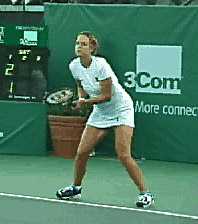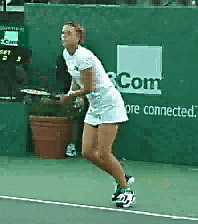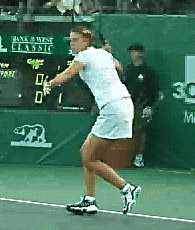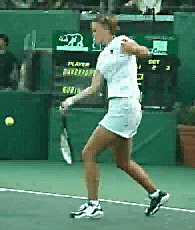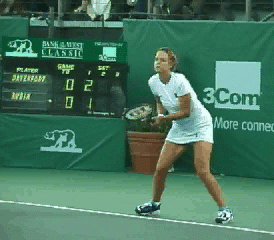|
TennisOne Lessons
Lindsay Davenport, 1998 US Open winner and 1999 Wimbledon winner, has just added the season ending Chase Championships to her trophy case by defeating Martina Hingis in the final. Solidly entrenched as number two in the world, Davenport has her sights fixed on the top spot and she has assembled the game to get there - booming, accurate serve, heavy and penetrating second serve, versatile backhand, great feel for the net, offensive and defensive tactical skills, and an outstanding forehand to boot. The Davenport ForehandLindsay started with Robert Lansdorp as did Pete Sampras, and their forehands show that common lineage - eastern grip, comfortable taking the ball early, excellent disguise. Her power comes from the natural rhythm of the stroke. In the animation, notice the peculiar finish. Peculiar, for anyone trained to have a long follow through “to the target”. Peculiar for anyone who finishes the shot with the racquet out in front, forming a “picture frame” for you to look through as you watch your shot. This finish is fast and loose. The racquet head gains incredible speed when the forward motion of the arm abruptly stops, causing all this momentum to jump quickly into the racquet via a pronounced rotation of the forearm. Do not try this on the courts if you are stiff, tight, or have tennis elbow. But if you have been trained to hold the racquet loosely, if you know that “tension is your enemy” then experiment with swinging up, out, around, and over the ball. The Grip
|
|||||||||||||
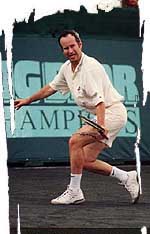
McEnroe used the continental grip for serve, backhand, forehand, and volley. |
The eastern grip is the most versatile. From the eastern position subtle grip changes create many opportunities. Lindsay can shift to a lower eastern and produce a little more topspin. Moving to a high eastern she can drive through or slightly under the ball (return or approach) or with the classic eastern as we see here she can step inside the baseline and rip the ball. The squareness of the racquet face in frame 4 speaks volumes about the eastern grip. Were she using the semiwestern, the racquet would be more closed and the upward momentum (and potential for mishit) greater.
Sampras strikes the forehand in much the same way. He is comfortable rallying, taking the ball early, driving the ball, or creating a little extra spin. Finally, for the net player, the grip change to the continental is easier from the eastern than from the semiwestern position.
Over the last couple of years, Lindsay's footwork and court speed have improved immeasurably. She is lighter and more fit for sure. I believe she will have a legitimate shot at the French Open when she believes in her ability to move. Here she can take a page from Arancha Sanchez’ book on footwork. When she does, she will have assembled the entire package.
Last Updated 9/1/98. To contact us, please email to: webmaster@tennisone.com
TennisONE is a registered trademark of TennisONE and SportsWeb ONE; Copyright 1995. All rights reserved.

